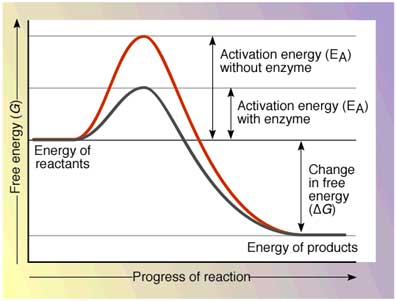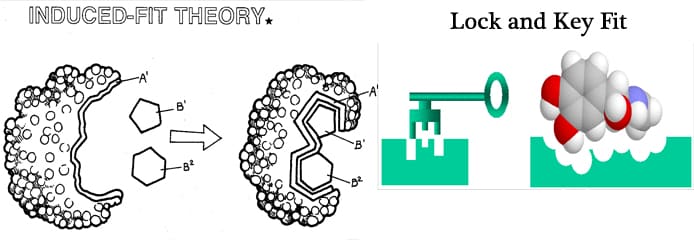- A Catalyst increases the rate of reaction by providing alternative energy pathway ; usually increasing the rate of by 1012-1020. However it does not affect free energy ∆G (can’t make endergonic reaction go). Instead an enzyme can couple an exergonic reaction with an endergonic reaction via ATP breakdown.
- It will decrease EA for a spontaneous reaction and make it proceed faster
- Often needed for molecules with HIGH KINETIC STABILITY (HIGH ENERGY BARRIER)
- Rate is proportional to # of molecules you can activate; therefore reduce EA. More molecules can be activated therefore increasing rate of reaction.
- Why do we need catalyst enzymes?
- Catalyst enzymes make reaction proceed faster with having to wait a long duration of time and without a significant increase in temperature.
Enzyme Structure
- Tertiary Structure (very flexible; bigger than substrate)
- Two theories of thought on how substrate active site– with enzyme wrapping around it
- INDUCED FIT: Initiates bonds between substrate and enzyme are weak; enzymes chances conformation upon binding to strength binding
- LOCK & KEY: The active site of enzyme is a rigid/ specific active site; however this fails to explain stabilization of transition state.
- **Substrate must be in the transition state to be catalyzed
- There is usually MUCH more substrate than enzyme and shift the reaction to the right
- An increase of temperature can lead to potentially more molecules reaching the EA
How do Enzymes lower EA?
- Orient substrate properly; makes substrate collide & react
- Change interaction, exposing it to alternative charge (ionic reaction)
- Changing shape of substrate molecule (forcing it into transition state)
- NOTE: Enyzmes do these things to increase probability of substrate reaching EA.


